CASBEE Family and tools
CASBEE is comprised of assessment tools tailored to different scales: construction (housing and buildings), urban (town development) and city management. These tools are collectively known as the CASBEE Family.
Tools for building scale
1) CASBEE for New Construction (CASBEE-NC)
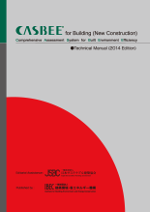
CASBEE-NC is mainly used by architects and engineers to increase the BEE value of a building during the design process. This can be used as a design support tool as well as a self-checklist. This tool, formerly called the DfE (Design for Environment) tool, makes assessments based on the design specifications and the anticipated performance.
Rebuilding projects are also assessed by CASBEE-NC. At any phase of the Preliminary Design, Execution Design or Construction Completion, the environmental quality and performance of the building and its load reduction performance can be evaluated. As environmental performance and scoring criteria change over time, the results of assessments remain valid only for three years after the completion of construction.
2) CASBEE for Existing Buildings (CASBEE-EB)
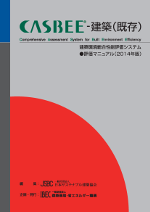
CASBEE-EB targets a number of existing buildings with an operational record for at least one year after completion. The tool was also developed to be applicable to the asset value assessment. With this tool, the performance achieved at the time of assessment is evaluated. The result is valid for five years and should be updated using the latest version of the assessment tool, because the condition of the building may change over time. It can be used as a labeling tool to declare the environmental performance of buildings. CASBEE-EB is also utilized to support building maintenance. Building owners, such as real estate agencies and large enterprises, may use it as a self-evaluation tool for mid- to long-term management plans.
3) CASBEE for Renovation (CASBEE-RN)

CASBEE-RN was designed to evaluate the performance of existing buildings based on specifications for renovation and the predicted performance. It can be used in renovating existing buildings or making proposals for building-operation monitoring, commissioning and upgrading designs with a view to ESCO (Energy Service Company) projects. It is valid for three years after the completion of renovation work, and assessment should be repeated with the latest version of CASBEE-RN available. This tool can be used to evaluate the degree of improvement of environmental performance relative to the level preceding renovation. CASBEE-RN may also assess the improvement of specific performance in relation to the purpose of renovation. For instance, the BEE for energy saving can also be evaluated; this is determined by scores for the assessment categories especially related to energy saving renovation, such as Energy (LR1) and Indoor environment (Q1).
4) Locally Customized Edition for Municipalities
A flexible response to regional characteristics is a common feature of all the tools of the CASBEE family. CASBEE-NC can be used by local authorities for construction administration. Local authorities using this tool can tailor it to local conditions, such as climate and prioritized policies. Changes are generally made by modifying the weighting coefficients. Building owners have to report the CASBEE assessment result to the local authority in the same way as an Energy Saving Plan and a building approval application. This system is introduced to the local authorities as a way to improve the environmental efficiency of buildings in the respective regions. One example is "CASBEE-Nagoya," which began in April 2004 under the building environmental consideration system of the City of Nagoya.
The information of the cities introduced CASBEE system and reporting results is shown on the Certification System page.
5) CASBEE for Interior Space
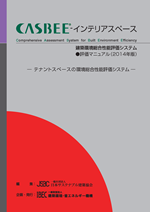
The assessment of CASBEE for Interior Space covers only the area that the tenant (such as a company) occupies in an office building, because the main purpose of this tool is to evaluate environmental measures and/or environmentally responsible initiatives conducted by the tenant itself. The assessment also includes indoor comfort, energy efficiency and water conservation of the building, earthquake resistance, and intellectual productivity. At present, only office buildings are assessable.
6) CASBEE for Temporary Construction (CASBEE-TC)
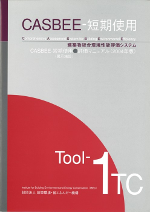
CASBEE for Temporary Construction was developed as an extension to CASBEE-NC for evaluating temporary buildings constructed specifically for short-term use, such as expo pavilions. Buildings of this type have short-term lifecycles and therefore consideration should concentrate largely on material use and recycling in the construction and demolition phases. The scoring criteria and weighting reflect the features of temporary buildings.
7) CASBEE for Heat Island Relaxation (CASBEE-HI)
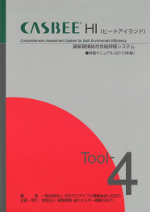
Assessment of the heat island effect is essential in major urban areas such as Tokyo and Osaka. CASBEE-HI is a tool aimed for more detailed quantitative assessment of heat island reduction measures in building design. In CASBEE-HI, the criteria deal with more detailed conditions in the outdoor thermal environment and heat island load on the surroundings. (These are also addressed in CASBEE-NC.)
8) CASBEE for Schools
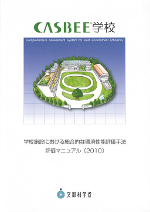
CASBEE for Schools was developed to assess primary schools and junior high or high schools. In Japan, there are an enormous number of old school facilities built in the 1960s or earlier waiting for renovation. CASBEE for Schools is designed for use especially at the planning and operation stages of buildings. Main target users are administrative officers in charge of the planning of educational facilities. To promote eco-friendly schools, CASBEE for Schools was modified from the CASBEE abridged versions for easy assessment of the schools.This tool was officially developed by Ministry of Education, Culture, Sports, Science and Technology.
9) CASBEE for Real Estate (formerly named as CASBEE for Market Promotion)
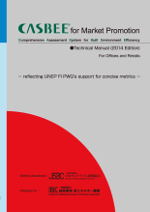
Originally, the CASBEE tools were intended mainly for design support use and were not widely used to promote green buildings in the real estate market. Recently, UNEP-SBCI, United Nations Environment Programme - Sustainable Buildings and Climate Initiative, proposed global common metrics called "the Sustainable Building Index." A simple, comparable and compatible system is crucial to decision-making regarding investment in green buildings. For investors, it is also necessary to cover the common metrics proposed by UNEP-SBCI. Thus, we decided to have CASBEE tools connected with property appraisal.
With this in mind, a very simple version of CASBEE was developed and launched in Japan. This tool has two aspects: the evaluation of environmental performance and the disclosure of environmental performance value (Index). A clear indication of environmental performance value is required in the real estate market, and it is important to disseminate such ideas.
The five issues, namely energy/GHG, water, materials, biodiversity/sustainable site, and indoor environment, compose the main categories of the tool, which also includes five from the Sustainable Building Index. With 21 assessment items in total, each of the five categories contains the prerequisite item. In regard to energy/GHG, the item "Public transportation access" is taken into account. "Soil Environmental Quality / Regeneration of Brown Field Sites" and "Measures Regarding Risk of Natural Disaster" contribute to biodiversity/sustainable site, as assessment items related to the site quality.
